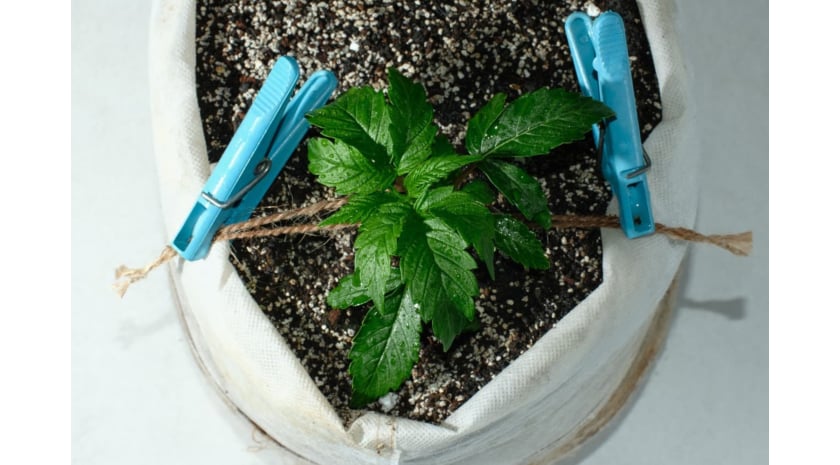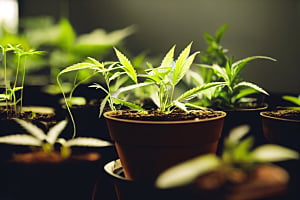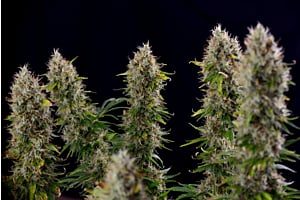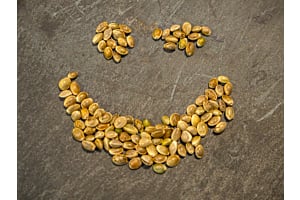Contents
What is low-stress training (LST)?
Pros and cons of training autoflowers
When to start and when to stop LST on autoflowers
How to LST autoflowers: 4 methods you need to consider
Some tips to improve your technique
3 strains to try the LST method
Is your grow op facing time or space constraints? You can LST autoflower plants to get photoperiod-tier yields while honoring the restrictions.
Low-stress training is an easy and effective way to increase harvests. It lets you manage plant height and shape, enhance light exposure, and optimize space usage. Whether you’re a new or seasoned cultivator, it’s a valuable addition to your tool belt.
Join us to learn about low-stress training for autoflowering strains. We discuss its benefits and drawbacks and offer practical ways to get started.
What is low-stress training (LST)?
Untrained marijuana displays apical dominance, which makes it resemble a Christmas tree. Since the top cola has the most access to light, the plant sends energy upward. Bottom and side bud sites generally remain underdeveloped.
This plant shape is excellent for species looking to survive in nature, but it’s not the highest-yielding.
Training means manipulating plant shape and size to increase the harvest potential. We divide it into high and low-stress training (HST and LST).
In HST, you snap or cut branches to coax plants into new shapes. LST is gently bending and tying stems to change growth patterns. Where the former is risky and advanced, the latter is a low-risk yield booster suitable for most cultivators.
LST lets you make the most of the available space and light. You break the apical dominance and get a flat, uniform canopy. Each bud site gets the “main cola” treatment, and there are no weak lower branches.
Despite these benefits, the topic of LST training autoflowers isn’t a complete no-brainer. Let’s see why.
Pros and cons of training autoflowers
Autoflowering weed seeds have a lot going for them. They offer fast returns, resist harsh weather and pests, and require minimal care. Their short vegging periods aren’t ideal for cultivators hoping to train, though.
Despite being low-stress, LST still harms the branches. Photoperiods take this damage in their stride, bouncing back in several weeks. Autos don’t always have several weeks to recover.
These strains automatically flower after 4–6 weeks of vegging. Since plant well-being predicts harvest size, keeping them healthy is usually the focus of auto cultivation.
Many autos are resilient and won’t wither under this amount of stress. Still, taking them through an LST regimen requires time, skill, and meticulous attention.
Want a quick way to weigh the risk and reward? Here are the pros and cons of autoflower LST at a glance.
|
Pros of training autos |
Cons of training autos |
|
Higher yields |
Higher maintenance requirements |
|
Larger, denser buds |
Losing the main cola |
|
Excellent light penetration |
Reduced visual appeal |
|
Improved airflow |
|
|
Less unhealthy stretching |
|
|
Better use of available space |
|
Benefits
Growers love LST because it makes plants manageable and high-yielding. Here are the tangible benefits you might reap by using this method.
Increased yields
Higher yields are the main reason people opt for crop training. Provide proper plant care, and LST may double the output of your garden.
This benefit is the culmination of the following five factors.
Big and dense buds
Apical marijuana usually has dense, chunky main cola and popcorn nugs at the base. Training lets you get dense buds from all sections of your plant.
Growing dense buds relies on light. When you LST autoflowers, every bud site has direct exposure to the lamp. You get a thriving garden whose energy goes towards growing and fattening the flowers.
More light to lower branches
The upper branches shade the base of bushy, cone-shaped plants. For this reason, the lower bud sites remain underdeveloped.
LST spreads out the plant, making the limbs sit flat. Light reaches them all, and no branch gets left behind. This increased exposure means you’ll see intense growth in vegging and flowering stages without investing in extra lamps.
Fresh airflow around your plant
Christmas tree-shaped plants get dense, and moisture may build up around the leaves. Excessive humidity may lead to mold, mildew, and bud rot if left untreated.
When you use LST, the branches are no longer close together. Air flows freely around the plant and keeps it healthy.
Reduced stretching
Seedling stretching may occur due to insufficient light exposure. It results in gangly plants with frail limbs that can’t hold plenty of flowers. Vegging weed may also get tall and slim due to weak lamps or excessive shade.
LST creates a flat canopy, so the plant doesn’t stretch to reach the light. It doesn’t grow past its limits, and its limbs remain strong.
Efficient use of space
How tall can a plant grow? Some strains quickly become towering giants. Cultivators in limited spaces may train plants to counter this tendency.
You can think of LST as an optimization tactic. It creates a lateral canopy uniformly exposed to light, and every branch produces hefty flowers. No square inch of the space goes towards unproductive plant material.
Drawbacks
Besides stressing the plant, which you can mitigate by maintaining perfect growth conditions, LST comes with several practical considerations. Here’s why cultivators might dislike it.
Extra time investment
Many people choose autoflowers for their no-frills nature. Besides feeding and watering, the plants need no work on your end.
LST requires you to check plant shape, remove leaves, and move stray branches. The maintenance is well worth the time investment, though, and takes just a few minutes each day.
Loss of the main cola
There’s pride in seeing the gorgeous, burgeoning central cola. Training prevents the Christmas tree structure, and you don’t get that massive flower.
Instead, low-stress training for autoflowers produces dozens of large bud sites. Their combined heft surpasses the central cola, making the garden even more impressive.
Atypical plant appearance
Many people rely on visual cues to tell whether they’re caring for cannabis right. LST alters its appearance, making plants grow sideways instead of apically. As a result, you don’t get that picture-perfect shape.
The buds are large, resinous, and numerous, though. It’s worth sacrificing visual appeal for harvest quantity and quality.
When to start and when to stop LST on autoflowers
Timing is everything when it comes to non-photoperiods. Let’s see when to start LST on autoflower plants and when to stop managing them.
Starting as early as possible is essential, as autos dash through vegging. Most growers begin low-stress training 2–3 weeks after germination. You can tie the stem as soon as you see the first true leaves.
The following month is the growth-intensive vegetative stage when the LST magic happens. The plants bloom after 4–6 weeks, and any stress becomes undesirable.
Stop low-stress training autos when they enter flowering, and heaps of pre-flowers cover the internodes. You don’t have to untie the branches, but loosen the bonds to minimize damage. Your only tasks in this stage are climate control and ensuring light goes to key areas.
How to LST autoflowers: 4 methods you need to consider
You know when to start LST on autoflowers, so let’s see how.
Popular approaches vary in simplicity, efficiency, and suitability to different strain types. Here are the four main ones you might consider.
Tie-down method
The tie-down method is the most straightforward LST technique for autos. It’s perfect for first-timers and requires minimal knowledge and equipment. You can even improvise the shape as long as you make the branches grow parallel to the soil.
|
Pros |
Cons |
|
Needs minimal equipment |
Bending may make the branch snap |
|
Easy to set up and maintain |
Needs daily checkups |
|
Flexible branch organization |
|
Here’s how to do it:
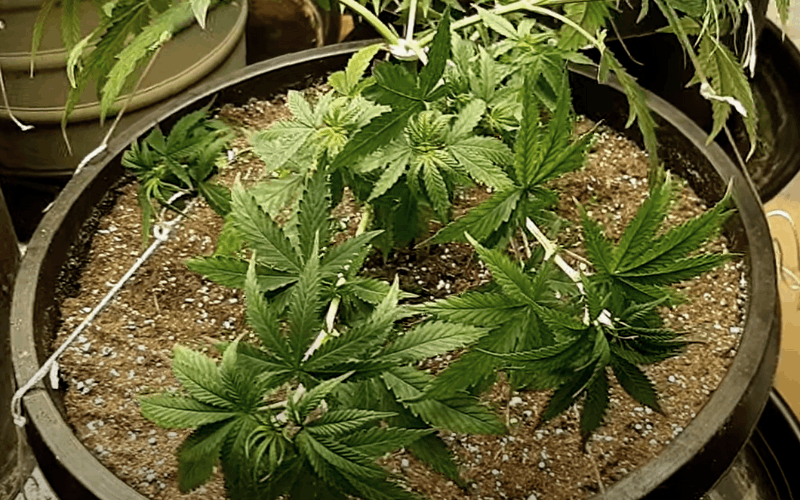
Gather the equipment. Get string or wire, a drill or clips, non-abrasive plant ties, and bamboo stakes.
Prepare the pots for training. Those using fabric containers can attach clips to their sides to hold the string. If your pots are clay, ceramic, or plastic, drill holes around the rim.
Transplant seedlings to the pots. Position a bamboo stake next to the stem to help the plant resist the pull of the ties.
Tie the stems. Attach the wire to a nearby hole or clip, gently bend the branch, and fasten it at an angle.
Maintain the new shape. Branches may start growing upward again, so check them daily and tie them back down by shortening the wire.
Screen of Green (SCROG) method
The Screen of Green (SCROG) is an advanced method of low-stress training autoflowers. Multiple plants grow through a mesh, creating a flat screen with bud sites.
|
Pros |
Cons |
|
Grow many plants in limited spaces |
Requires additional equipment |
|
Suitable for stretchy strains |
One ill plant can ruin the batch |
|
Branches get structural support |
|
|
Multiple large colas per plant |
|
Here’s how to do it:
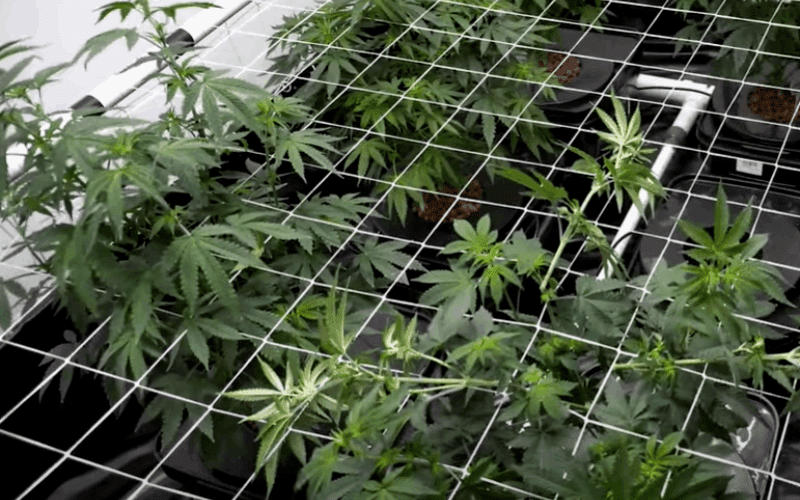
Create a screen for plants. You can run strings across a wooden frame or attach trellis netting to your pots. Any DIY technique works as long as you make it sturdy.
Install the screen several inches above the plants. You can attach it to the light fixtures or add stakes below for support.
Weave and tie the branches. Move each stem through the mesh, bend it away from the center, and fasten it to the frame. Work from the outer layer inward.
Maintain the screen shape. New branches may grow upward, so weave and tie them in place as they pop up. Strengthen the strings if the limbs start pushing up.
Vertical SCROG method
Do you have a single light source in your grow room or tent? Vertical SCROG will make your garden flourish. Plants grow vertically around a lamp, making the setup suitable for large spaces.
|
Pros |
Cons |
|
Easy access to buds |
Requires a lot of space |
|
Excellent for tall strains |
Needs considerable upkeep |
|
Optimal light exposure |
|
|
Requires a single lamp |
|
Here’s how to do it:
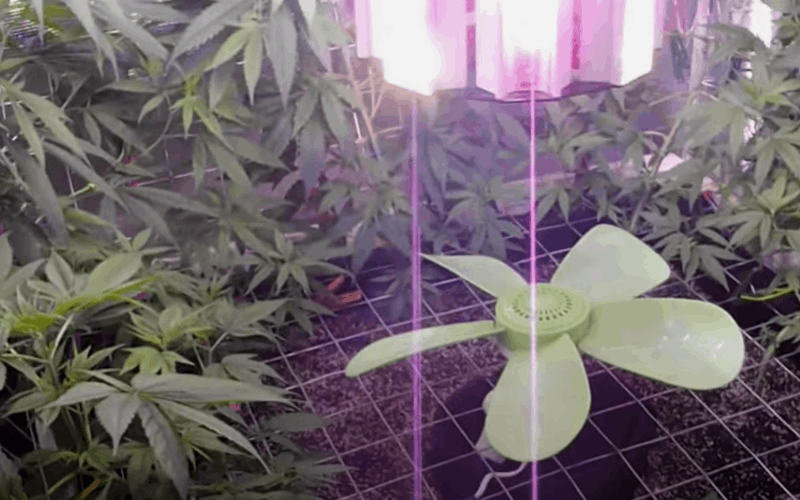
Create a mesh as you would for regular SCROG. Consider using a material that easily bends, like plastic wire.
Position the mesh between the pots and the light source. Fasten it in place.
Weave the branches through the mesh and gently tie them with strings.
Maintain the structure by moving the taller branches to higher holes and shorter ones to the bottom. That way, you avoid having some limbs shaded.
Some people create cylindrical screens around the lamp. The buds sit inside this tube-like structure, and light loss is minimal. The only downside is that your weed becomes hard to access.
Sea of Green (SOG) method
The Sea of Green is the perfect method for low-stress training autoflower crops in low-ceiling rooms and tents. The plants sit close and form a singular canopy. There’s no tying involved, making it a favorite among rookies. You need at least four to set everything up.
|
Pros |
Cons |
|
Multiple juicy top colas |
Hard to access some plants |
|
No branch bending required |
Easy for pests to spread |
|
The plants stay compact |
|
|
Grow numerous plants in limited spaces |
|
Here’s how to do it:
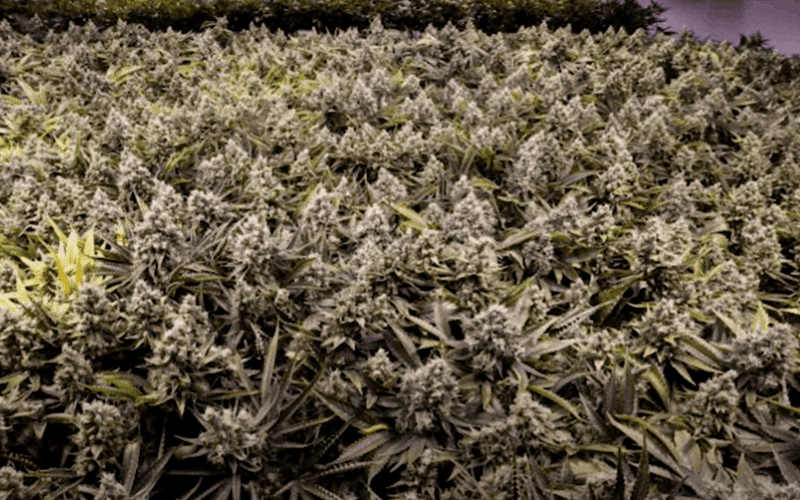
Place the pots in a tightly packed configuration. Ideally, one container per square foot of available space.
Install netting on top of the plants. They grow top-heavy, and nets keep them from competing for dominance.
Remove the side branches. Not many develop in SOG, but those that do redirect energy from the canopy. Cut them away in mid-vegging.
Defoliate the lower branches before flowering starts. Each plant should focus on the top cola, which will grow thick and heavy.
Some tips to improve your technique
Learning how to low-stress train autoflowers introduces extra considerations to your cultivation journey. Why rely on trial and error when you have growing experts in your corner?
Here are some practical tips:
- Be careful while bending the branches. Test their flexibility between your fingers before tying them, and don’t push to their limit. Snapping plant limbs can stunt growth.
- Use soft materials. Avoid metal wire and thin nylon, as they can damage the stems. Opt for rubber, cotton, and soft plastics instead.
- Avoid high-stress methods. Expert cultivators sometimes combine HST and LST (for example, topping and SOG). Autos don’t have time to recover from damage, so keep this idea for photoperiods.
- Be mindful of stretching. Slim, overstretched branches result from a lack of light, so supplement or intensify your lamps if they occur.
- Maintain optimal conditions. Excessive heat and humidity lead to health problems, and light burn causes slow flowering growth. These issues reduce the harvest potential, so dial in the conditions to keep them prolific.
- Know if and when to LST autoflowers. If a seedling looks weak, wait for a week before bending it. If it remains frail, it’s better to grow without training than to risk injuring it.
- Check the attachment points. Ensure the plant ties aren’t moving and hurting the branch. Tie them firmly to avoid harmful friction.
- Protect the space from pests and disease. All methods but the tie-down keep the plants close together, and infestations are hard to quarantine. So, seal your room and disinfect everything before use.
3 strains to try the LST method
The new generation of hybrids is sturdier than ever, negating the idea you should only train photoperiods. Strain choice still affects your success rates, though.
As a rule, avoid LST for autoflower plants if working with sensitive cultivars and use it on hardy and branchy ones. For example, these three strains from our store can handle stress and thrive:
- AK-47 autoflower is an indica-dominant strain with 17–21% THC, predominantly physical effects, and sweet-and-spicy scents. It’s resilient, short, and stocky, making it suitable for SOG. Keep plants in high-light, low-humidity environments, and yields reach 14 oz./m2.
- Amnesia autoflower is a sativa-dominant strain with 10–19% THC, uplifting effects, and a sweet fruit-pepper aroma. The plants are tall, branchy, and ideal for tie-down or SCROG training. They require high-light conditions and dry air, yielding 21 oz./m2.
- Blueberry autoflower is an indica-dominant strain with 19–21% THC, heavy, soothing effects, and alluring fruit scents. It’s short, bushy, and very easy to grow. The dense foliage and side branches suit SOG and tie-down methods. The yields reach 15 oz./m2.
Low stress for high yields
Autoflowers struggle to recover from high-stress training methods. LST doesn’t cause much real damage, though: there’s no reason not to use it to boost yields.
LST is also a great way to manage your autos’ growth and effectively spend your time and resources. Choose hardy strains, stay on top of plant care, and start early for the best results.
Now you know when and how to LST autoflowers, why not put these techniques to practice? Visit our shop to buy high-quality seeds and launch a non-photoperiod garden. Stay tuned to our blog for more cultivation guides.

 THC
THC